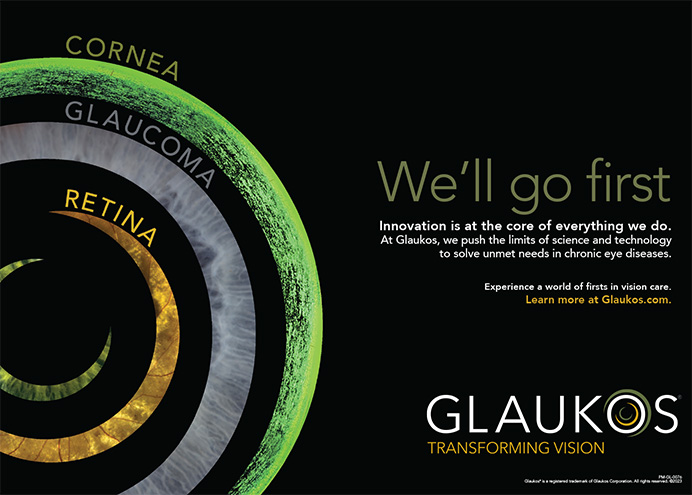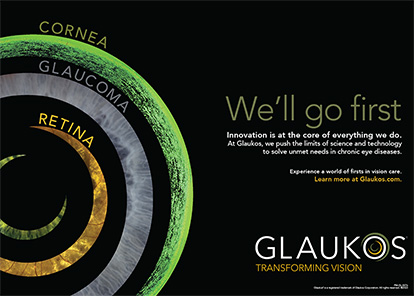I have performed tens of thousands of RK surgeries over the years, and I have had to provide excimer laser enhancements to some of these patients. This article reviews the necessary workup and discusses the appropriate options for treatment.
SUBJECTIVE COMPLAINTS, EXAMINATIONS
Most patients who have undergone RK will present with hyperopia, hyperopic astigmatism, or occasionally residual myopia or myopic astigmatism. Whatever the patient’s residual refractive error, his or her workup is the key to success.
First, listen to the patient’s subjective complaints to determine their severity and if there is a presbyopic component. Post-RK visual fluctuation is common, and it is imperative to determine if the patient experiences this problem during the day. Second, the workup should involve two examinations: one in the morning and one in the evening. Although conducting two examinations is not the standard of care, I recommend this approach, and I favor performing a manifest refraction and a cycloplegic refraction during both visits. The patient may not be pleased at the prospect, but the need for two examinations should be stressed to him or her at the outset. The numbers obtained may differ dramatically, and they will influence the treatment.
PREOPERATIVE COUNSELING
The visual outcomes of patients who experience a loss of BCVA due to higher-order aberrations after RK often will not be improved by excimer laser ablation. It is crucial that the patient be properly informed of this possibility. The corneas of many post-RK patients are too irregular to produce reliable wavefront aberrometry. If useful aberrometry can be obtained, however, I prefer a customized ablation. In the future, these patients may be good candidates for topography-guided ablations.
Often, RK patients will have ocular surface disease that must be treated prior to the refractive workup. Ocular surface disease will significantly affect the patient’s refraction and the proposed treatment and outcome. Ocular allergies and eye rubbing are common in these patients. They should be encouraged to refrain from rubbing their eyes, and their ocular allergy should be treated aggressively.
Once I obtain a stable refraction, I categorize the patient to create a treatment algorithm (Table 1). Patients with myopia or myopic astigmatism are the easiest to treat. I prefer transepithelial PRK in these cases, and I ensure that older patients do not have a nuclear sclerotic component that is creating a refractive myopic shift. For a video demonstration of my technique, visit http://eyetube.net/?v=smag.
The next category of patients has hyperopia or hyperopic astigmatism and no variance in their refractive error. I prefer to treat these patients using alcohol-assisted epithelial-removal PRK. For a video demonstration of my technique, visit http://eyetube.net/?v=sapes.
It is important to counsel these individuals that it may take 1 to 2 weeks for their vision to stabilize. If I choose surface laser vision correction as the option, it is important to note that I use mitomycin C 0.02% for 12 seconds at the end of the treatment. Some surgeons favor LASIK for these eyes, and I do not denigrate that modality. Mechanical keratectomy is also a choice, although the radial incisions can split and epithelial ingrowth can be a problem. Most surgeons do not perform keratectomies with a femtosecond laser, because the laser’s gas may follow the path of least resistance and break through the radial incision. The occurrence of epithelial ingrowth has led to my preference for surface ablation in these cases. The outcomes of both LASIK and PRK are similar; the major difference between them is the time to visual rehabilitation.
PRESBYOPIA IS PROBLEMATIC
Presbyopia presents a problem in post-RK patients. In these cases, my first step is a contact lens trial to answer the question of monovision as an option. If it is successful, I will target full or modified monovision. If laser vision treatment is the path chosen, I am more confident having a solid target refraction from the preoperative testing. The final category of patients is those with presbyopia and early nuclear sclerosis. These patients present with 20/25 to 20/30 BCVA and may not distinguish between their loss of vision from nuclear sclerosis versus a residual refractive error. Laser vision correction on these patients leaves them disappointed. I therefore discuss with these individuals the options of an accommodating or a mono-focal lens. I do not believe multifocal IOLs are appropriate in these patients. They already suffer from a decreased level of vision in terms of contrast sensitivity, so the implantation of a multifocal lens will only worsen their situation and lead to complaints and frustration.
Correct IOL power calculations are important. Current formulas are useful, and intraoperative wavefront aberrometry provides additional information to ensure the accurate placement of a properly powered lens. If the patient opts for an intraocular procedure, I suggest placing incisions in the sclera rather than the cornea. Also, surgeons should expect an early hyperopic response that will regress. To avoid a prolonged postoperative discussion of this phenomenon, patients need to be thoroughly informed preoperatively.
One final note with regard to the patient with fluctuating vision: current corneal collagen cross-linking technology offers new treatment options to help stabilize these complaints, although the procedure is not approved in the United States. Cross-linking does not always reduce the fluctuation, but it may help these patients perform better visually throughout the day and one day to the next. Although adjustments of treatment nomograms are still in the developmental phase, cross-linking has the potential to help the problematic patient. Only time will tell if the procedure may be performed on more patients in the future.
CONCLUSION
The biggest pearl I can offer is to spend as much chair time as possible with the post-RK patient prior to any intervention: it will save many postoperative headaches. I stress to patients that they should learn as much as they can about the technologies among which they are choosing for their treatment. I also emphasize that postsurgical healing times will probably be longer than they expect.
Karl G. Stonecipher, MD, is the director of refractive surgery at TLC in Greensboro, North Carolina. Dr. Stonecipher may be reached at (336) 288-8523; stonenc@aol.com.


